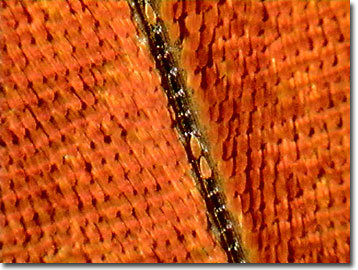Butterfly Wing Scale Digital Image Gallery
Tropical Leafwing
As South America's version of the leaf butterflies found in African, Indo-Australian, and Oriental regions, tropical leafwing butterflies are an excellent illustration of convergent evolution. Convergent evolution occurs when species with different ancestors evolve into a similar appearance, which develops as a result of adaptation to living in similar environments.

Also known as Zaretis itys and the goatweed butterflies, tropical leafwings are extremely variable in wing and body coloration. Males vary like the color of leaves during the dry season, from bright red to pale yellow. Females feature a conspicuous tan area on their forewings, which resembles a skeletonized leaf, and have a more pointed abdomen and larger forewing spots than male tropical leafwings. As members of the of the brush-footed butterfly family, Nymphalidae, tropical leafwing butterflies exhibit a highly modified front pair of legs that are extremely hairy and are not used for walking.
The behavior of a tropical leafwing butterfly depends upon its environment and situation. Generally, the adults are strong fliers with powerful wing beats. However, male butterflies prefer to sit and wait on perches, rather than roam, when looking for suitable mates in order to conserve energy. If disturbed, the tropical leafwings do not hesitate to use their flying power. The butterflies quickly soar into the forest canopy and then fold up their wings in order to blend in with their surroundings. In northern populations, adult tropical leafwings hibernate in bark crannies, tree trunks, and other areas where they can be protected from detection and potential predation.
Wild coffee is a favorite food plant of tropical leafwing caterpillars and its leaves contain a wealth of phytochemicals, which may provide predator defense to the species through chemical sequestering. The larvae are gray-green with many pale, oddly shaped points, the thickest of which is a green-highlighted hump at the rear of the thorax. Mature larvae feature a pair of widely spaced, blunt, peg-like horns on their heads that are splattered with green granules. For additional defense, the larvae form frass chains at the ends of leaves by binding particles of their droppings together with spun silk. The result is a jumble of debris that provides the caterpillars with some protection from predaceous ants.
The tropical leafwing butterfly species and its congenerics are popular in butterfly collections prepared for science courses and museums because they illustrate camouflage mimicry and convergent evolution so well. Originally quite rare in private collections, butterfly hunters have since learned to lure wild individuals to traps baited with fermenting fruits. Although they are considered relatively common in the wild, subject to population boom-and-bust cycles, the status of tropical leafwing butterflies is at risk as tropical forests are continually destroyed. Particularly problematic, the habitat requirements of this elegant insect overlap with economically important coffee plantations, which results in their subjection to frequent and intense pesticide applications.
Tropical Leafwing Butterfly Images in Darkfield Illumination
Wing Vein and Fur - The fur of the tropical leafwing butterfly appears like numerous wire fish hooks under high magnification. A supportive vein is also a prominent feature of this unique photomicrograph.
Tropical Leafwing Butterfly Images in Oblique Illumination
Wing Scales and Vein - High magnification and oblique light clearly reveal the angular ridges on the edges of a tropical leafwing's scales. A thick, transparent vein runs through the center of the image.
Wing Scales and Fur - Strands of fur slant across this wing scale image, which gives it an interesting streaked appearance.
Tropical Leafwing Butterfly Images in Reflected Light
Orange Wing Scales - The colors of the tropical leafwing vary, but the wing scales of this specimen are the rusty orange often associated with autumn.
Brown Wing Scales - Here, another area of scales is displayed. Their dark and rough appearance is a stark contrast from the smooth waves of scales displayed in the previous image.
Contributing Authors
Cynthia D. Kelly, Shannon H. Neaves, Laurence D. Zuckerman, and Michael W. Davidson - National High Magnetic Field Laboratory, 1800 East Paul Dirac Dr., The Florida State University, Tallahassee, Florida, 32310.
BACK TO THE BUTTERFLY WING SCALE IMAGE GALLERY
BACK TO THE DIGITAL IMAGE GALLERIES
Questions or comments? Send us an email.
© 1995-2025 by Michael W. Davidson and The Florida State University. All Rights Reserved. No images, graphics, software, scripts, or applets may be reproduced or used in any manner without permission from the copyright holders. Use of this website means you agree to all of the Legal Terms and Conditions set forth by the owners.
This website is maintained by our
Graphics & Web Programming Team
in collaboration with Optical Microscopy at the
National High Magnetic Field Laboratory.
Last Modification Friday, Nov 13, 2015 at 01:19 PM
Access Count Since January 21, 2003: 19911
Visit the website of our partner in introductory microscopy education:
|
|
